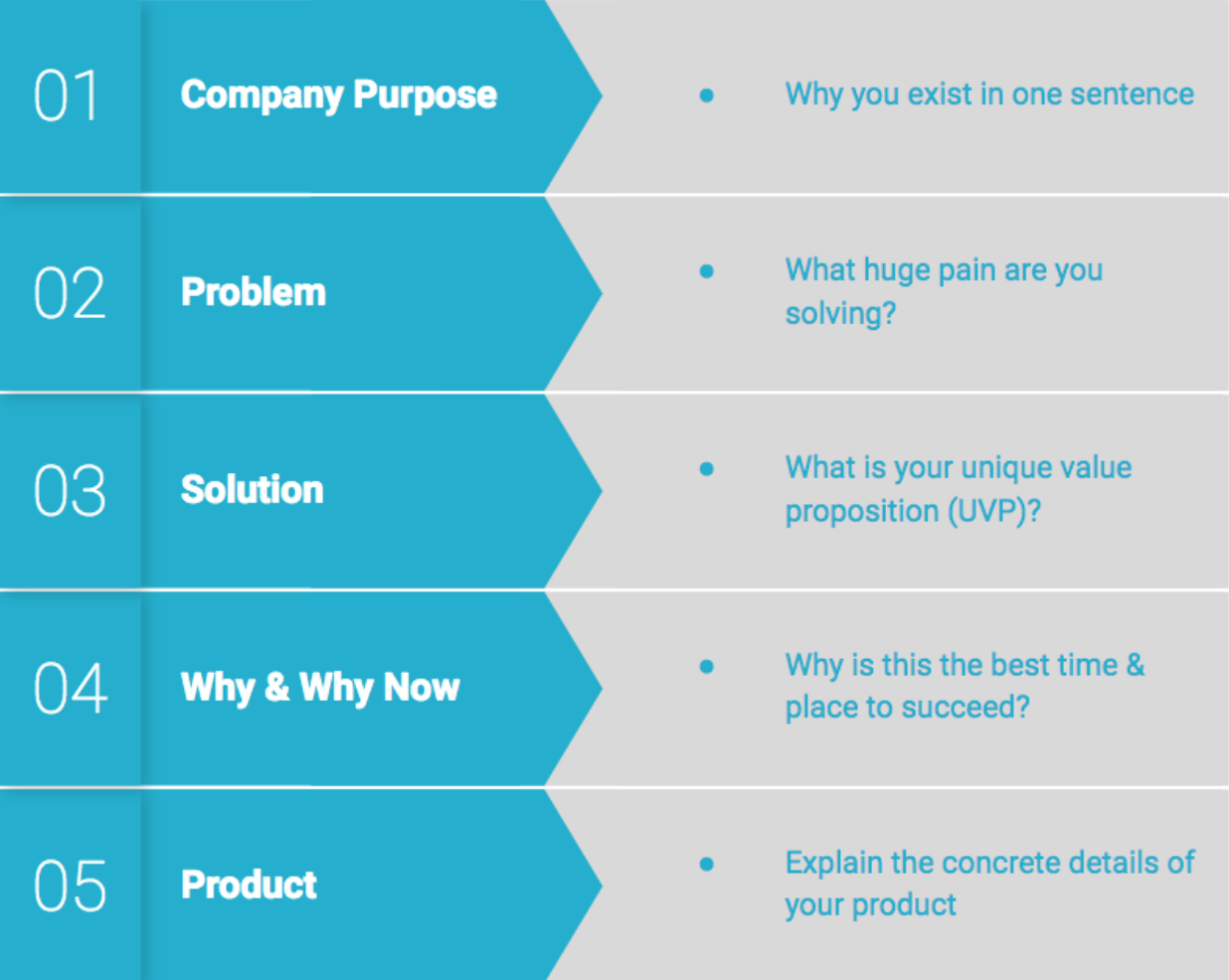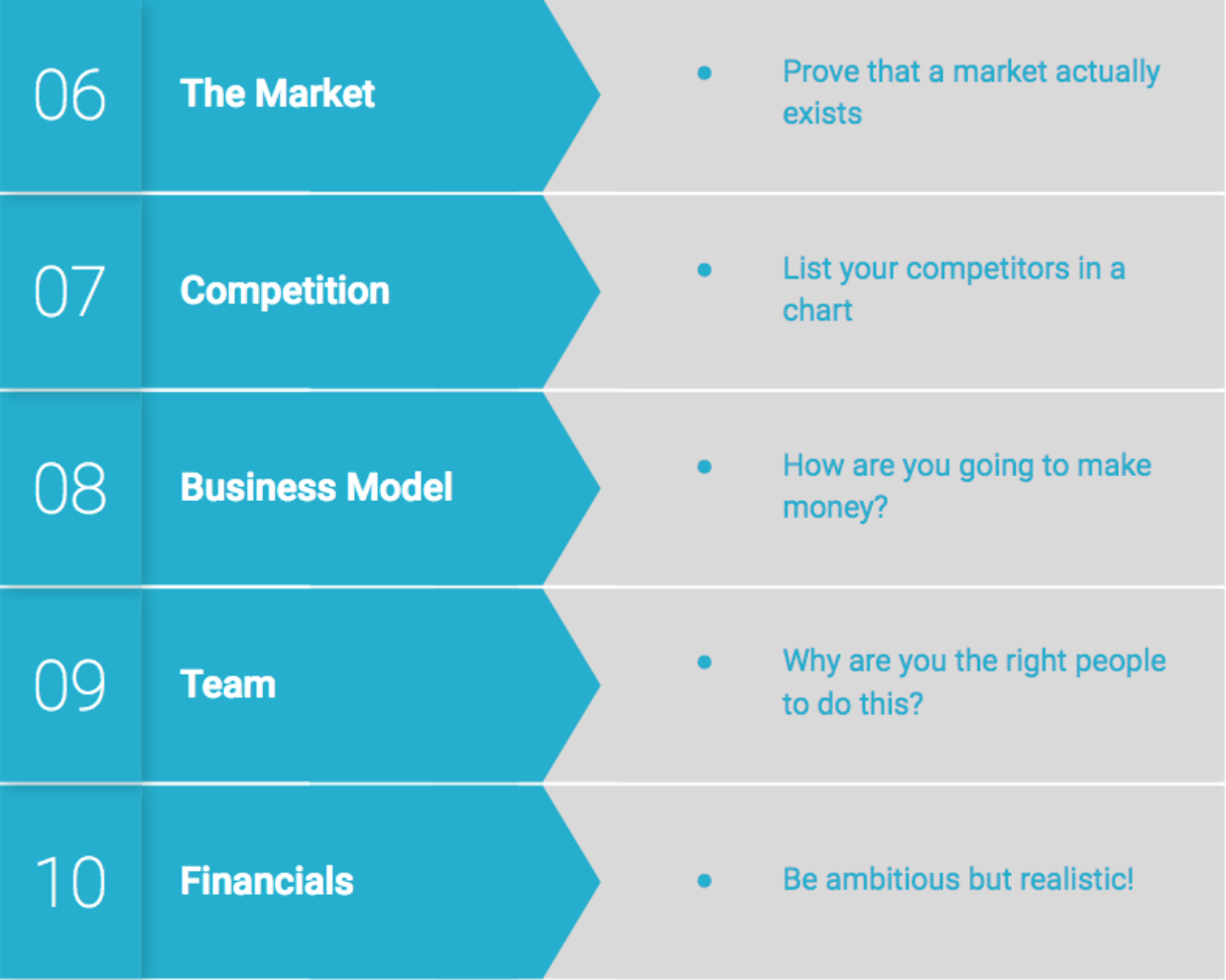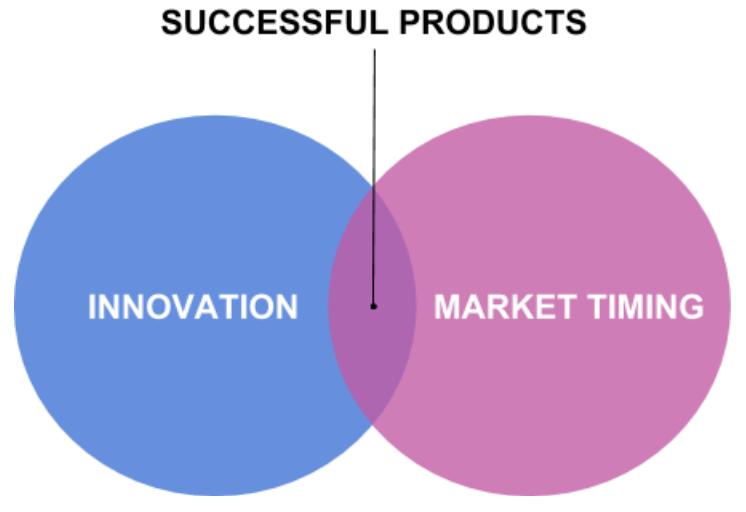In my last blog, I introduced you to the 5 things you need to know before you start pitching, and now I’m going to take you through a ‘starters-pack’ pitch deck.
If you’re planning to join us for Asia Pacific’s largest startup pitch competition, Pitch for $1 Million, it’s essential you have a good pitch deck ready on the day.
If you’re just beginning to put your first pitch deck together, then this is a great place to start.
In the graphic below, I outline 10 standard slides that will help you create a clear presentation for your pitch. Of course, as your product & company grows and evolves, you may want to add more slides or change existing ones to deviate from this. There are also many slightly different variations of these, and the order can be switched up, but you’ll find that most investors expect to see something along these lines.
Each one comes with an explanation of the key points that should be covered on that slide. I’ll then take you through the first five in more detail so by the end of this blog, you’ll be halfway to completing your first pitch deck!


1. Company Purpose
This is your one sentence pitch to explain the reason your business exists and why it matters. This is also often referred to as your company mission or vision. Think of this as your first impression, how you introduce your company to the world.
Here’s a familiar example:
Amazon’s vision is to be Earth’s most customer-centric company; to build a place where people can come to find and discover anything they might want to buy online.
Notice some really key uses of language here. Amazon highlights that their vision is to be completely global, that they put the customer first and that they aim to be able to sell absolutely anything their customer might desire.
When putting your own company purpose together, start by thinking about who your audience is and what your ambitions are in terms of offering, scale, market share. You could come up with your company purpose by thinking “Where would I ideally like my company to be in 5 years?” or “If I were to reach 100% of my company goals what would I have achieved?” Essentially where are you trying to get to.
2. The Problem
This is where you sometimes need to ignite the imagination of the person(s) you are pitching to. You need to show the pain you’re going to solve is both significant and monetizable. Explain why the problem you are solving is so big or so painful that customers WILL pay for the product or service.
You may also want to explain how customers address the issue today and why it sucks. Use stats if you can, particularly if you’re making bold claims.
Here’s an example:
There is a tremendous need for innovative and cost-effective tech-based services for seniors.
MackHelp has identified many growing communities such as x, y & z in Region A where 35% of the population is over the age of 65 and living on their own.
According to Report Y, 20% of seniors have serious concerns about finding affordable homecare services. Activities seniors rated as difficult or unable to complete included housework, shopping, preparing meals and accessing transportation.
(You don’t have to put all this text in your slide, but it’s worth knowing the key points to address here)
Here, the fictitious MackHelp has identified their audience and the issues they face. It is clear from their knowledge & stats that they understand their market and have researched this issue. They demonstrate clearly that although there are services available it is not satisfying the market.
Ps. Don’t forget to cite your sources if coming from independent reports.
3. The Solution
Now that they care about the problem, how do you solve it?
It’s time to demonstrate your Unique Value Proposition in the solution slide of your pitch deck. This is where you tell them that you can provide a better, if not the best possible solution. It needs to be a feasible product that customers will use instead of what’s currently available.
Not just why they should buy, but why should they buy from you.
Here’s an example from TOMS’:
With every pair you purchase, we’ll give a pair of new shoes to a child in need. One for One.
Most of us are familiar with the concept behind the socially conscious footwear brand, but think back to when they were one of the first to offer this value prop. It demonstrated very clearly how they were different from other shoe companies.
How about Dominos’:
You get fresh, hot pizza delivered to your door in 30 minutes or less or it’s free.
Dominos isn’t just solving the problem of people being hungry for pizza at home, they are doing it in a way that is better than the rest.
This isn’t just a slogan but actually the core DNA of their businesses.
I get pitched a million SaaS businesses a day talking about how they solve a particular problem for their customers, but what they often fail to outline is why their solution is unique valuable.
You might notice that in both of the brands mentioned above, the USP was so powerful that many other businesses have since copied them. That’s what you should aim for.
Watch out! A lot people mix up this slide with the product slide, and end up simply describing what their product does (there’s a slide for that, and it’s coming below).
When creating your solution slide for your own startup pitch deck, aim for something just as clear.
4. Why, but more importantly, why now?
Timing is paramount in the technology and startup world. You might have found a great opportunity, but if you have to wait for the market too long, eventually you’ll run out of money.
If you look at many of the solar startups in the last decade, most came to market too early and eventually failed, because oil prices were going down and solar panels were still more expensive.

Let’s think about Facebook for example, it was definitely not the first social networking space. Remember Bebo, MySpace, and Friendster? In 2008, at its peak, Myspace had over 75 million users, but 2008 was also the first time Facebook overtook Myspace in user numbers (with Facebook now having over 1 billion). Facebook put forward the right product for this generation and MySpace quickly became outdated.
It is therefore important to demonstrate the ‘why now?’.
Here’s an example:
Google searches for ‘problem with MackWidget’ have grown at least 200% month on month since Q2 2017
This shows that issues with the fictitious MackWidget is something that people are searching for on Google. If your product is designed to fix that issue then the continued growth of this issue demonstrates that right here, right now, there is potential for exponential growth in your customer base.
Talk about what is happening in the world right now that proves this is the right time for you to succeed.
5. The Product
Yes, this is where we get to what your product or service actually does.
You may notice that up until now we haven’t actually given much information about your company’s product. Why you might ask? Shouldn’t I get them excited about my product and what I’ve built (or am building) right away?
No.
Why? Because timing is everything, and when it comes to your startup pitch, you need to keep people engaged. The best way to do this is to tell a story.
Okay, so now it’s time to describe the concrete details of your product. You may remember the example I used in my previous blog post, with two descriptions of the fictitious MackBot. The first was vague and fluffy with too many buzzwords and the second was clear and demonstrated knowledge of the industry and customer base.
Here’s the second one again:
MackBot has built Google’s type-ahead search box as a Magento plugin. It boosts search-to-purchase conversion and Average Order Value.
This example lets people visualise the product by comparing it to something familiar – Google’s search. It also conveys that the product or MVP already exists – by using the word ‘built’. It mentions the tech stack (Magento) so we understand who the market might be.
These are all concrete details.
It’s important to highlight the functionality, design, architecture, and intellectual property of your startup in concrete details rather than fluffy words.
This is your chance to get down to the nitty gritty of your product. Highlight what makes this unique, such as a particular element of the design or technology you are using.
To Conclude…
So there we have it, the first 5 slides of your pitch deck.
I really hope you’ll have got the hang of what’s expected so you can go ahead and create the next 5 based on the graphic above.
In my next blog, I’ll be summarising some Dos and Don’ts in pitches.
If you’re a seed to series A startup looking for funding to take your business to the next level, make sure to register for your closest Pitch for $1 Million Regional Final before tickets sell out!






